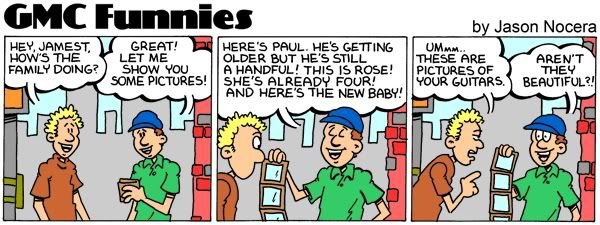Modes, Modes |
|
|
|
|
|
| Jan 7 2009, 03:43 PM |
|
And THAT is one of the most usefull posts about a theory... it's an easy way of understanding it all
Thanks man... gotta print it. |
|
|
||
|
|
|
|
| Jan 7 2009, 03:49 PM |
|
Thanks so much! Glad it helped!
-------------------- www.youtube.com/Wallimann
www.davidwallimann.com |
|
|
||
|
|
|
|
| Jan 7 2009, 04:38 PM |
|
hmmm..... so, rythming with power chords you can choose whatever mode you like for soloing, right?
|
|
|
||
|
|
|
|
| Jan 22 2009, 02:44 PM |
|
What I meant by vamp is a backing track made of only one chord played over and over. It would be quite a boring backing track, but if you have only one chord to play over, you have more options as far as modes go. As long as the modes you use include the notes of the chord, you're allowed to do that.
If you want to play something in G Phrygian, here's whet you need to do (that can be applied to any modes and any keys). 1. Write the notes of the mode you are working with, in this case G Phrygian: G-Ab-Bb-C-D-Eb-F 2. Harmonize the scale into 3 or 4 note chords (3 note chords are generally used in straight rock, 4 notes for more complex sounding chords such as jazz...) You need to build these chords from every note which will give you 7 chords in the end. The chords are built by taking the Root (1st note of your chord), 3rd, 5th and 7th. Here is what we get for G Phrygian: 1st Chord G-Ab-Bb-C-D-Eb-F G min7th (Root, min3rd, 5th, min7th) 2nd chord G-Ab-Bb-C-D-Eb-F-G AbMaj7 (Root, Maj3rd, 5th, Maj7th) 3rd chord G-Ab-Bb-C-D-Eb-F-G-Ab Bb7 (Root, Maj3rd, 5th, min7th) 4th chord G-Ab-Bb-C-D-Eb-F-G-Ab-Bb Cmin7 (Root, min3rd, 5th, min7th) 5th chord G-Ab-Bb-C-D-Eb-F-G-Ab-Bb-C Dmin7b5 (Root, min3rd, b5th, min7th) 6th chord G-Ab-Bb-C-D-Eb-F-G-Ab-Bb-C-D EbMaj7 (Root, Maj3rd, 5th, Maj7th) 7th chord G-Ab-Bb-C-D-Eb-F-G-Ab-Bb-C-D-Eb min7 (Root, min3rd, 5th, min7th) So to recap, here are the chords you can use to build a G Phrygian chord progression: Gmin7 AbMaj7 Bb7 Cmin7 Dmin7b5 EbMaj7 Fmin7 So for example, you can have: Gmin7-Bb7-Cmin7-AbMaj7  example1.mp3 ( 432.96K )
Number of downloads: 388
example1.mp3 ( 432.96K )
Number of downloads: 388You can also experiment with common bass chords. In other words keep your bass in G for a solid foundation, then add chords on top of that. That will really make your backing sound Phrygian as all the chords you are playing have a very strong connection to the bass. For example: Gmin-AbMaj7/G (That's an Ab Maj7 chord with a G on bass).  example2.mp3 ( 432.15K )
Number of downloads: 359
example2.mp3 ( 432.15K )
Number of downloads: 359That will sound very phrygian... Here's a video I did on that subject a while back.. Let me know if you need anything else! :-) This post has been edited by David Wallimann: Jan 22 2009, 02:44 PM -------------------- www.youtube.com/Wallimann
www.davidwallimann.com |
|
|
||
|
|
|
|
| Jan 23 2009, 01:56 PM |
|
You might have more questions after this, don't hesitate to ask! :-)
-------------------- www.youtube.com/Wallimann
www.davidwallimann.com |
|
|
||
1 User(s) are reading this topic (1 Guests and 0 Anonymous Users)
0 Members:






















